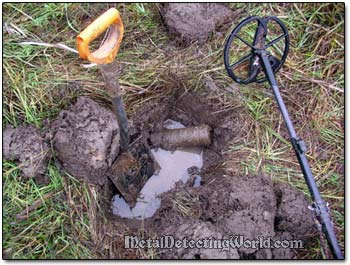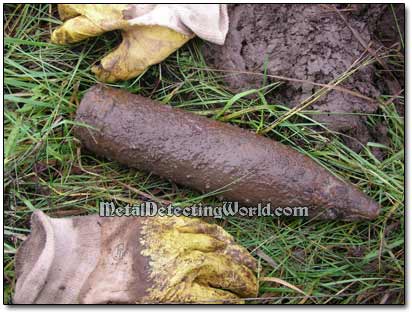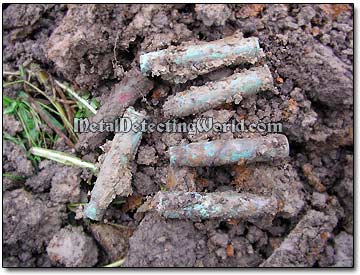Part I - Metal Detecting at the Swedish Tavern Site, page 30
3rd Hunt - Discovering WW2 German and Russian Relics
As soon as the weather gave us a break, we arrived to the site for the third metal detecting hunt. This time, I began detecting outside the "triangle" and in the thick grass on the slopping elevation side.

Right away I received a loud signal - a "bang"! I knew it was a large object but did not expect to dig up an artillery projectile from the World War II!

It was an unexploded projectile of a small calibre, fired either by the tank gun or by the light field cannon.
A Projectile Fired by a Tank Gun or Light Field Artillery

Most likely there was a small battle going on between the Red Army troops and the pro-fascist 658th battalion of Omakaitse at this spot in February 1944 when the Soviet forces of the Leningrad front liberated Kingisepp. The Red Army forced the German Luga river defense line at several points and swept to within five miles near the Estonian border. Then the Soviet forces had advanced on a broad front, mauling the retreating German divisions.
The 658th Ostbattaillon of Omakaitse (Home Guard or Self-Defense) - Estonian national and military organization that was the "Eastern unit" of the Wehrmacht (the Nazy German Regular Army), served in the Leningrad front line and in this area. Led by Major Alfons Rebane who acted for the commander of the 20th SS Division "Estonian" (20.Waffen-Grenadier-Division der SS (estnische Nr.1)), the 658th battalion conducted numerous punitive raids against civilians around the city of Kingisepp and the village Kerstovo and burned down many villages (Babino, Khabalovo, Chigirinka, etc.).
In Estonia, the Omakaitse battalions were known for killing jews, soviet-supporters and prisoners of war. One time, the Omakaitse shot 12,000 civilians and dump them into the anti-tank ditch near the city of Tartu in Estonia.
...The closer I was getting to the top of the elevation - an important military strategic point, the more WW2 relics I was digging up.
Brass Casings of the Machine-Gun Ammunition Were Dug Up

Digging the WW2 relics had never been "my cup of tea" because I had never enjoyed touching the traces of the most horrible and devastating war in the history of mankind. But on a few occasions like this one, I had to dig through the WW2 layer to get down to the old coins and artifacts, or at least to confirm their presence (or absence) at the spot.